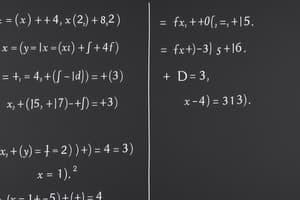Podcast
Questions and Answers
What is the main property of a function in mathematics?
What is the main property of a function in mathematics?
- Each input is related to multiple outputs
- Each input is related to multiple inputs
- Each input has no relation to any output
- Each input is related to exactly one output (correct)
Which set refers to the possible inputs of a function?
Which set refers to the possible inputs of a function?
- Domain (correct)
- Range
- Polynomial
- Exponent
For the function f(x) = x^2, what is the range of this function?
For the function f(x) = x^2, what is the range of this function?
- Non-negative real numbers (correct)
- Complex numbers
- Positive integers
- All real numbers
Which type of function involves sin, cos, and tan?
Which type of function involves sin, cos, and tan?
What kind of function is f(x) = 3x + 4?
What kind of function is f(x) = 3x + 4?
In a function, what does each x being paired with exactly one y signify?
In a function, what does each x being paired with exactly one y signify?
What is the significance of representing the position of an object as a function of time in physics?
What is the significance of representing the position of an object as a function of time in physics?
In engineering, how do engineers typically use functions?
In engineering, how do engineers typically use functions?
What role do functions play in economics?
What role do functions play in economics?
How are functions applied in computer science?
How are functions applied in computer science?
Which mathematical field heavily relies on functions to analyze data and make predictions based on probability distributions?
Which mathematical field heavily relies on functions to analyze data and make predictions based on probability distributions?
What is a cycloid curve described by in terms of parametric equations?
What is a cycloid curve described by in terms of parametric equations?
Study Notes
Functions in Mathematics
In mathematics, a function is a relation between a set of inputs and a set of permissible outputs with the property that each input is related to exactly one output. Functions can have many uses, from describing how objects move to analyzing real-world situations like traffic flow. In this article, we will dive into the concept of functions and their applications in math.
Understanding Functions
Functions are used in various mathematical contexts such as algebra, calculus, and geometry. They help in representing relationships between different quantities. A function is defined as a set of ordered pairs (x, y) such that each x is paired with exactly one y.
Domain and Range of a Function
The domain of a function refers to the set of all possible inputs or x-values for a given function. The range, on the other hand, is the set of all possible outputs or y-values. For example, consider the function f(x) = x^2. The domain of this function would be all real numbers because you can square any real number. However, the range would be non-negative real numbers because squaring any number will always produce a positive value.
Types of Functions
There are several types of functions based on their behavior. Some common ones include linear functions, quadratic functions, polynomial functions, trigonometric functions, exponential functions, logarithmic functions, and inverse functions. Each type of function follows specific patterns and rules.
Applications of Functions
Functions find extensive applications in various fields such as physics, engineering, economics, computer science, and statistics. Here are a few examples of how functions are used:
-
Physics: In mechanics, the position of an object is often represented as a function of time. This helps analyze motion and predict future positions.
- Cycloid: When a circle rolls along a straight line without slipping, a curve called a cycloid is produced. This curve can be described by the parametric equations x = (a(θ + sinθ)) and y = a(1 - cosθ).
-
Engineering: Engineers often work with functions to model complex systems and analyze data. For instance, they might use calculus to optimize designs and solve problems related to fluid dynamics or structural integrity.
-
Economics: Economists rely on mathematical models to understand economic behavior. Functions play a crucial role in representing relationships between variables such as supply and demand, inflation rates, and consumer preferences.
-
Computer Science: Programmers frequently encounter functions when writing code to perform specific tasks. This includes everything from simple calculations to handling inputs and outputs in software applications.
-
Statistics: Statisticians use functions to analyze data and make predictions based on probability distributions. Examples include calculating means, medians, and standard deviations.
In conclusion, functions are fundamental to mathematics and have wide-ranging applications in various disciplines. Understanding different types of functions and their properties is essential for solving real-world problems and exploring deeper mathematical concepts.
Studying That Suits You
Use AI to generate personalized quizzes and flashcards to suit your learning preferences.
Description
Test your knowledge of functions in mathematics with this quiz covering the basics of functions, domain and range, types of functions, and their applications in various fields like physics, engineering, economics, computer science, and statistics. Explore the fundamental concepts and practical uses of functions in real-world scenarios.




